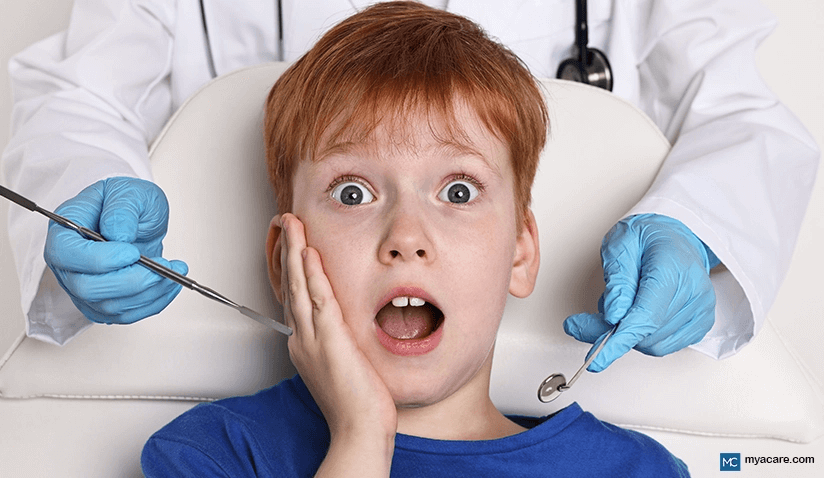Common Dental Problems in Children

Dental problems in children can affect their health, growth, speech, and overall quality of life.1 For instance, the presence of decays in teeth can decrease food consumption and chewing efficiency, which can lead to malnourishment.2 Improper development of permanent teeth, if unchecked, can have consequences later in life and also affect self-confidence. As such, it is valuable for parents to understand common dental problems in children. Below are a few common dental problems faced by children that would require the attention of a pedodontist, or pediatric dentist.
Early Childhood Caries or Tooth Decay
Commonly observed in infants up to 5 years
As per the Global Burden of Disease Study 2017, over 530 million children suffer from decay in milk teeth. The presence of decay on surfaces of milk teeth, seen in children up to 5 years of age is indicative of early childhood caries (ECC). The presence of decayed teeth in children younger than 3 years is considered a severe form of ECC.
Baby bottle-fed tooth decay or nursing caries denote the presence of decay in an infants’ teeth. It affects infants who are still nursing and are not entirely on solid foods. This is mainly linked to the inappropriate use of milk bottles (e.g., adding sweeteners to the bottle; sleeping with a milk bottle in the mouth). Research suggests that prolonged night-time breastfeeding in toddlers has increased risk of developing ECC.2
Baby bottle-fed tooth decay is predominantly present on surfaces of upper front teeth and the upper (occlusal) surface of molar teeth. It mainly involves upper teeth due to increased deposition of milk and other sugary liquids in upper teeth while breastfeeding or intakes through a bottle. A visit to a dentist at this age can help in early detection of decay in young children.3
When other teeth are decayed, it is referred to as rampant caries of childhood.3
To prevent caries risk, it is recommended that fluoride varnish be applied on the child’s teeth once in 6 months from the time of appearance of milk teeth until 5 years of age. This is done by the pedodontist.4
Malocclusion in Children
Commonly observed in children above 7 years of age
Malocclusion is the presence of misaligned teeth, mainly caused by factors such as genetics, the difference in shape or size of the jaw and teeth, soft diet, adverse oral habits, breathing problems, premature loss of teeth, and delayed restoration. Among children with milk teeth, malocclusion is due to adverse oral habits.5
It is recommended to visit a dentist at the age of 7 to evaluate if the child has developed malocclusion. Visit at an early age (before the appearance of all permanent teeth) can aid in initiating minor corrections which are easier to treat. It also brings awareness among parents about corrective measures for conditions such as protrusion of teeth, lack of space for permanent teeth, and skeletal and dental malformation.6
Adverse Oral Habits
Commonly observed in children above 3 years of age
Oral habits such as thumb or finger sucking, use of a pacifier, mouth breathing, tongue thrusting, lip biting, and grinding of teeth beyond 3 years of age can negatively impact the alignment of teeth. These habits can affect the speech, along with physical and emotional development of child.7
- Thumb or finger sucking: It is the most common oral habit. Children usually stop this habit by 4 years of age. Prolonged behavior can lead to dental deformations such as anterior open bite (a condition where front teeth do not meet on biting), increased protrusion of upper teeth, speech defects, and finger defects. If the child continues with this habit beyond 5 years of age, contact a pediatric dentist for necessary measures or appliances to break the habit.8
- Pacifier: The use of pacifiers beyond 3 years of age can negatively impact teeth development. Severe dental effects are seen if it continues beyond 5 years.8
- Mouth breathing: Airway obstruction due to enlarged adenoids (patch of tissue in the throat), tonsils, or inflammation of sinuses can cause mouth breathing. Habitual mouth breathers can cause disturbances in the balance of oral and surrounding area muscles. Many other dental abnormalities may develop along with the drying of gums leading to inflammation of gums.9
- Tongue thrusting: It is the habit of pushing the tongue forward between upper and lower teeth while swallowing. This can cause malocclusion or sometimes the presence of malocclusion can cause tongue thrusting.9
- Lip biting: This habit can cause a disturbance in the position of the upper and lower front teeth. The habit could be related to dryness of lips and cause increase in the size of the lip and can cause cracks or sores on lips.8
- Bruxism: Grinding or clenching of teeth is known as bruxism. This causes wearing away of upper (occlusal) surfaces of teeth, fracture of teeth, and in severe cases can affect the muscles and joints of the face. It is very rarely found in children with milk teeth.10
Dental Trauma
Commonly observed in children above 3 years of age
It is very common for young children to hurt their teeth, especially when they’re learning to walk and run. ~25% of school-going children also experience dental trauma. Upper front teeth and surrounding soft tissue (gums and lips) are most vulnerable to injuries such as displacement of the tooth within the socket, fracture of the crown portion of the tooth, and knocked out tooth. This is considered a dental emergency and requires immediate intervention from a pediatric dentist.11
Gum Diseases
Commonly observed in children above 5 years of age
Inflammation of gums is less common in preschoolers when compared to children above 5 years of age. A severe form of gum inflammation is observed during puberty. This can be attributed to hormonal changes in the body while attaining puberty. Some amount of gum inflammation is associated with the development of teeth or nutritional deficiencies (especially vitamin C). These conditions get aggravated with poor oral hygiene. Periodontitis (loss of bone and supporting tissues around teeth) is also observed in young children.12
When Should a Child Visit the Dentist?
The American Academy of Pediatric Dentistry and American dental association recommend that a child should visit a dentist by 12 months of age, with regular check-ups every 6 months.13
Benefits of An Early Visit to the Pediatric Dentist 14
- Early detection of structural abnormalities or presence natal teeth (if any).
- Counselling of parents on teething, oral hygiene maintenance, feeding, sleeping habits, and preventive measures to prevent early childhood caries.
- Timely evaluation of the sequence and structure during development of milk teeth and permanent teeth.
- Detection of premature loss of primary teeth and required intervention.
- Regular and early visits can help the child overcome fear and anxiety associated with dental clinic visits.
To search for the best healthcare providers offering dentistry, please use our search engine. We currently have providers in India, Malaysia, Singapore, Spain, Thailand, Turkey, the UAE, the UK and the United States
To search for the best healthcare providers worldwide, please use the Mya Care search engine.

Dr. Shilpy Bhandari is an experienced dental surgeon, with specialization in periodontics and implantology. She received her graduate and postgraduate education from Rajiv Gandhi University of Health Sciences in India. Besides her private practice, she enjoys writing on medical topics. She is also interested in evidence-based academic writing and has published several articles in international journals.
References:
Featured Blogs



